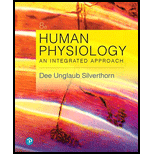
a.
To determine: The comparison between compliance and elastance.
Introduction: Lungs are the primary organ of the respiratory system. Lungs receive the gases from the outer environment and transport the oxygen into the blood. Lungs also eliminate the carbon dioxide from the body.
b.
To determine: The comparison among inspiration, expiration, and ventilation.
Introduction: The air enters the nose during inhalation. After that air move to the nasal passage, pharynx, larynx, tracheas, bronchi, and bronchioles. After passing the bronchioles, the air enters the alveoli. The gaseous exchange takes place at alveoli.
c.
To determine: The comparison between intrapleural pressure and alveolar pressure.
Introduction: Alveoli are the smallest sac-like structure present in the lungs. The exchange of gases takes place in alveoli. Pleura is the membrane that encloses the lungs from both sides.
d.
To determine: The comparison between total pulmonary ventilation and alveolar ventilation.
Introduction: The gaseous exchange between the atmosphere and the lungs is called ventilation. In general, ventilation is a combination of inhalation and exhalation per minute.
e.
To determine: The comparison between type I and type II alveolar cells.
Introduction: Alveoli are the smallest sac-like structure present in the lungs. The exchange of gases takes place in alveoli. Alveoli are like a spherical bubble; due to which surface tension is developed by the fluid surrounding the alveoli.
f.
To determine: The comparison between pulmonary circulation and systemic circulation.
Introduction: Lungs are the primary organ of the respiratory system. Lungs receive the gases from the outer environment and transport the oxygen into the blood. Lungs also eliminate the carbon dioxide from the body.
Want to see the full answer?
Check out a sample textbook solution
Chapter 17 Solutions
Pearson eText Human Physiology: An Integrated Approach -- Instant Access (Pearson+)
- What is the opening indicated by the pointer? (leaf x.s.) stomate guard cell lenticel intercellular space none of thesearrow_forwardIdentify the indicated tissue? (stem x.s.) parenchyma collenchyma sclerenchyma ○ xylem ○ phloem none of thesearrow_forwardWhere did this structure originate from? (Salix branch root) epidermis cortex endodermis pericycle vascular cylinderarrow_forward
- Identify the indicated tissue. (Tilia stem x.s.) parenchyma collenchyma sclerenchyma xylem phloem none of thesearrow_forwardIdentify the indicated structure. (Cucurbita stem l.s.) pit lenticel stomate tendril none of thesearrow_forwardIdentify the specific cell? (Zebrina leaf peel) vessel element sieve element companion cell tracheid guard cell subsidiary cell none of thesearrow_forward
- What type of cells flank the opening on either side? (leaf x.s.) vessel elements sieve elements companion cells tracheids guard cells none of thesearrow_forwardWhat specific cell is indicated. (Cucurbita stem I.s.) vessel element sieve element O companion cell tracheid guard cell none of thesearrow_forwardWhat specific cell is indicated? (Aristolochia stem x.s.) vessel element sieve element ○ companion cell O O O O O tracheid O guard cell none of thesearrow_forward
- Identify the tissue. parenchyma collenchyma sclerenchyma ○ xylem O phloem O none of thesearrow_forwardPlease answer q3arrow_forwardRespond to the following in a minimum of 175 words: How might CRISPR-Cas 9 be used in research or, eventually, therapeutically in patients? What are some potential ethical issues associated with using this technology? Do the advantages of using this technology outweigh the disadvantages (or vice versa)? Explain your position.arrow_forward
 Comprehensive Medical Assisting: Administrative a...NursingISBN:9781305964792Author:Wilburta Q. Lindh, Carol D. Tamparo, Barbara M. Dahl, Julie Morris, Cindy CorreaPublisher:Cengage LearningBasic Clinical Lab Competencies for Respiratory C...NursingISBN:9781285244662Author:WhitePublisher:Cengage
Comprehensive Medical Assisting: Administrative a...NursingISBN:9781305964792Author:Wilburta Q. Lindh, Carol D. Tamparo, Barbara M. Dahl, Julie Morris, Cindy CorreaPublisher:Cengage LearningBasic Clinical Lab Competencies for Respiratory C...NursingISBN:9781285244662Author:WhitePublisher:Cengage- Essentials of Pharmacology for Health ProfessionsNursingISBN:9781305441620Author:WOODROWPublisher:Cengage





